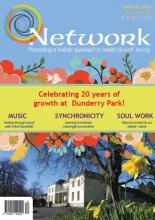The Importance of Ritual and Ceremony
by:
Marike Peek
Published:
Friday, June 12, 2015

Do you remember the number pictures we made as a child? A seemingly random collection of dots all of the sudden made sense as connecting them turned them into a recognizable picture, maybe a bit wobbly or angular, but a picture nonetheless. I can still recall the sense of awe and excitement I felt as the picture slowly revealed itself to me, emerging from the very movement of my fingers.
Life and our sense of identity often resemble those pictures, each dot representing a life-stage that we enter or a life-choice that we make. Not so long ago the choices we could make in our life were much more limited, our life path much more clearly marked out, in particular for women. Educational, professional and relational choices were limited and we mostly stayed within our social, cultural and religious group without venturing too far away from home. Life’s transitions were consequently quite clear and they were celebrated at almost fixed points in life in a one-size-fits-all fashion. They were not easily questioned as they were very much an integral part of our religious, cultural and societal fabric even if we felt uncomfortable with them.
In modern life the picture is, quite literally, very different and much more complicated. Our social, religious and/or gender identity are no longer defined by the group into which we are born and we have become free to be what and who we aspire to be at any given moment in time. This means we are now free to choose (and change) our career, partner, religion, place of residence and even our body, right down to our sex. This gives us the incredible power to be creative in how we want our life to be depicted in form. Although the changes within our social fabric have been liberating and mostly positive, some side effects that came with them have been unforeseen and may, in some cases, be undesirable.
First, in a world so full of choice and possibilities it becomes increasingly difficult for people to commit themselves to one thing, be it a career, partner, place of residence or social group as to commit to one thing is also to forfeit another. I cannot be committed to a relationship while at the same time continue to lead the life of a bachelor or a singleton. I cannot be committed to adulthood and at the same time continue to shun adult responsibilities in favour of childish behaviour. And as different roles in our lives require different modes of behaviour, language and even presentation, a sense of continuity was replaced by unchecked fragmentation as our lives broke in so many pieces we could no longer see the whole of which we remain to be a part.
Second, we lost the structures that were there to remind us of a greater reality, our connection to life and our community and that were used to transit from one stage of life to the next. This happened partly due to our desire to chase all possibilities in life, to not to be restricted by our commitment to anything, and partly because the structures themselves failed to adapt enough to stay relevant in a rapidly changing society and culture. Finally, a cultural and social inability to make a distinction between outward religious affiliation and personal spirituality played a part in discarding rituals as valid means of connecting and healing, leaving many with very few means of giving meaning to their life and circumstances.
Third, in our technologically advanced age, we tend to forget that life itself is an extremely powerful force, forever moving and creating. The core of my being is firmly and irrevocably connected to the core of all being. The mystery of life often works deep beneath the surface, like tectonic plates, fragmenting, pushing and re-creating. Therefore we are moved along through life by powers that cannot be controlled by us. This process is mostly slow but at times the movement is sudden and violent, spewing lava, creating earthquakes, moving mountains and opening abysses in what, just a moment ago, was a peaceful and well known landscape.
Many turn to therapy to deal with the debris that life in its violent outbursts leaves behind. This is invaluable in our efforts to recognize what has happened and how it has affected our life. But recognition in itself is not always enough. It is the first, very important, step in a much larger process as after recognition comes rejoining, repositioning, and finally releasing. Rituals are the place where all of this happens or has the potential to happen.
To understand what rituals are and where their power lies we can define rituals as:
“A holistic process of words, actions and gestures that carries transformative and liberating powers and which brings a sense of stability, structure and relationality into our lives and through which we intentionally, purposefully and playfully alter our perception and frame of reference.” (Tom Driver)
The key word in this definition is perception. Rituals do not alter reality or circumstances as change is always irreversible. However, like the masters of martial arts who use the energy of the enemy’s attack to their own advantage, ritual can help us learn to harness the tension and the pain that inevitably rolls through our lives and transform them into positive emotional energy we need to ‘get on with life’.
Unfortunately, within most religious traditions, both celebratory and consolatory rituals have become instruments of a power that can only be used successfully in the hands of the professional (ie, the clergy). This attitude reduced the very people for whom the ritual was intended to audience, making them spectators instead of active participants. Initiation rituals of ever increasing authority created a hierarchy of power that left the masses virtually powerless. As we have seen in many religious traditions, rituals that give power to only a few can quickly become formalized into rigid ideological concepts. And as rituals were lifted out of day-to-day life into the realms of higher echelons they withered and died as their creative life force was cut off from its source and became fossilized.
This becomes immediately apparent when we look at rituals of transition and how they can play a vital role in our life. Transitional rituals are vehicles that can help us to move from one year to the next or from one life stage to the next as they close and open doors while taking up the space ‘in the middle’; the threshold. They are performed at moments of critical change in a person’s life, most significantly at birth, entering puberty/ adulthood, marriage and death.
However, over the past decades the role and the significance of these rituals have been diminished in the life of many people because the transformative and redemptive power of rituals had been put solely into the hands of the authorities. In many cases transition rituals are still being re-enacted but often out of habit or a sense of ‘propriety’ even if they have become empty, almost meaningless. In other cases they are simply abandoned. In general only the party, which used to be the celebration of a meaningful transition into a new phase of life, remains and becomes the new focal point. Now, an 18th birthday becomes an opportunity to get legally drunk for the first time instead of an entering point into adult life.
Occasionally people are brave enough to invent their own rituals to give meaning and direction at significant cross roads of life. Often non-religious or pagan but others rooted in (more than one) religious tradition that is adapted, expanded, transcended into a new spirituality that is better fitting to their needs, life style and views. This is necessary as Irish society has changed significantly over the past 15 years in composition, colour, religious outlook and opportunity.
For people to continue to be able to connect the dots, this diversity can be a new way to make sense of Life, offering opportunities to create meaningful and fitting transitions. To once again be participants in the inevitable and joyful process that is Life itself.
About the author:
Marike Peek has been living in Ireland since 2000. She has a keen interest in spirituality, philosophy and different ways to educate and has worked for many years at Raheen Wood Steiner school as a handwork teacher. She is in the process of starting a ceremony and celebration business.
Latest Issue
Upcoming Events
-
17/04/2020 to 26/04/2020
-
18/04/2020
-
23/04/2020
-
15/05/2020 to 23/05/2020
-
16/05/2020 to 17/05/2020
Recent Articles
Article Archive
- November 2011 (2)
- January 2012 (3)
- February 2012 (2)
- March 2012 (2)
- April 2012 (4)
- May 2012 (4)
- June 2012 (1)
- July 2012 (3)
- August 2012 (2)
- October 2012 (2)

